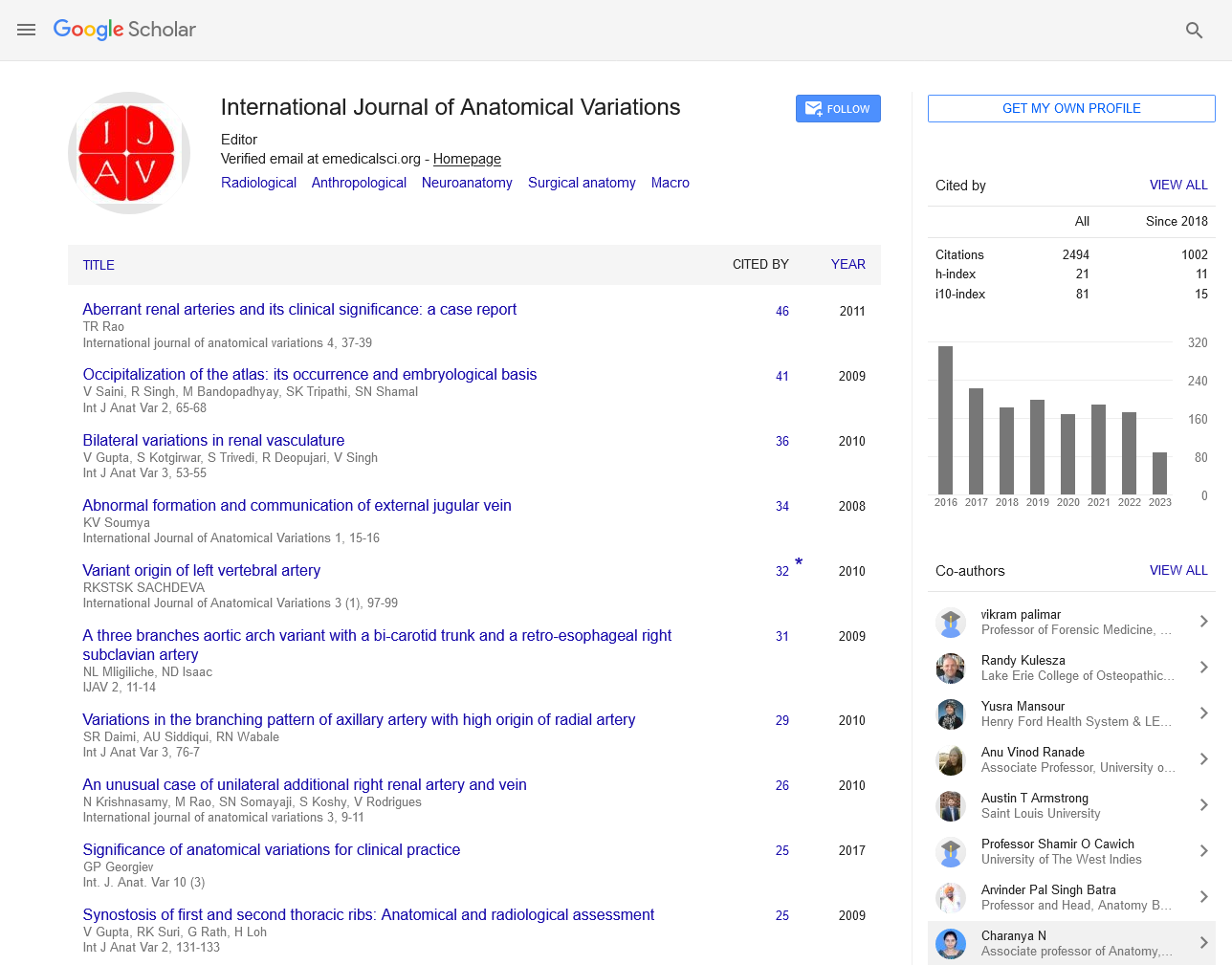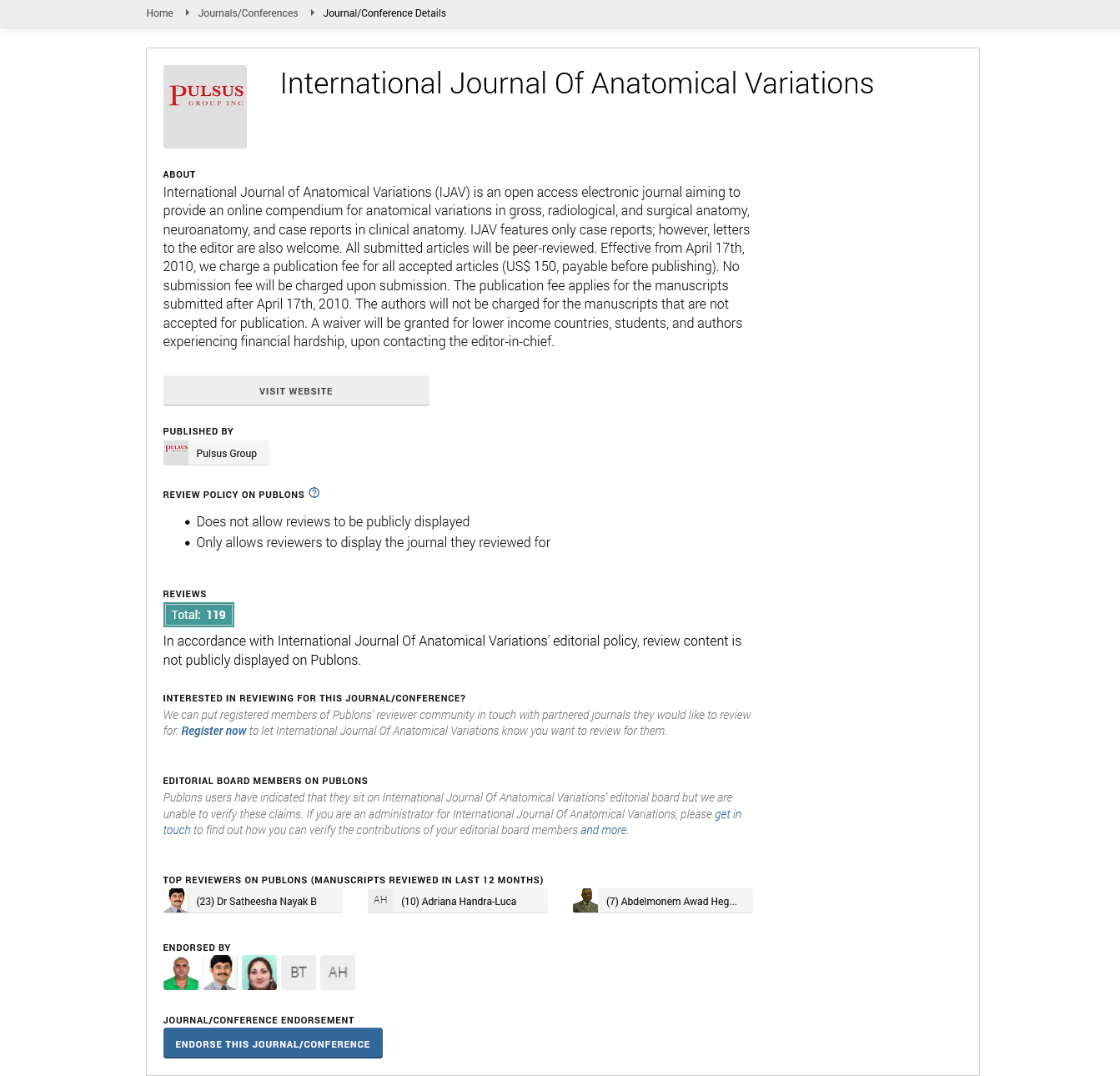Human Anatomy A Comprehensive Overview of Structure Function and Modern Advances
Received: 01-Apr-2025, Manuscript No. ijav-25-7670; Editor assigned: 04-Apr-2025, Pre QC No. ijav-25-7670 (PQ); Reviewed: 21-Apr-2025 QC No. ijav-25-7670; Revised: 26-Apr-2025, Manuscript No. ijav-25-7670 (R); Published: 30-Apr-2025, DOI: 10.37532/13084038.18(4).504
Citation: Nayak A. Human Anatomy A Comprehensive Overview of Structure Function and Modern Advances. Int J Anat Var. 2025; 18(4): 776-777.
This open-access article is distributed under the terms of the Creative Commons Attribution Non-Commercial License (CC BY-NC) (http://creativecommons.org/licenses/by-nc/4.0/), which permits reuse, distribution and reproduction of the article, provided that the original work is properly cited and the reuse is restricted to noncommercial purposes. For commercial reuse, contact reprints@pulsus.com
Abstract
Human anatomy is the scientific study of the structure and organization of the human body. It serves as a foundational discipline in the fields of medicine, biology, and health sciences, providing critical insights into how the body functions in health and disease. This article reviews the major anatomical systems, historical development of anatomical knowledge, methodologies for anatomical study, and recent advances including imaging and molecular anatomy. A comprehensive understanding of human anatomy is essential for clinical practice, medical education, and biomedical research.
INTRODUCTION
Human anatomy is the branch of science concerned with the bodily structure of humans, encompassing macroscopic (gross) anatomy and microscopic anatomy (histology) [1]. The study of anatomy dates back to ancient civilizations but has continuously evolved through technological advances and scientific inquiry. As an essential cornerstone of medical education, anatomy provides the framework for understanding physiological processes, diagnosing diseases, and performing surgical interventions. This article aims to offer an integrative overview of human anatomy, including its historical context, key anatomical systems, techniques of study, and modern advancements shaping the field today [2].
HISTORICAL DEVELOPMENT OF HUMAN ANATOMY
The origins of anatomical study can be traced to ancient Egypt and Greece, where early physicians such as Hippocrates and Galen made foundational observations. During the Renaissance, figures like Andreas Vesalius revolutionized anatomy through systematic dissection and detailed illustration, challenging longstanding misconceptions [3]. Modern anatomy combines classical dissection methods with advanced technologies such as computed tomography (CT), magnetic resonance imaging (MRI), and electron microscopy, allowing for precise visualization and understanding at multiple scales.
ANATOMICAL SYSTEMS
Human anatomy is commonly divided into several major systems, each with distinct structures and functions. The skeletal system comprises 206 bones in the adult human, providing structural support, protection for vital organs, leverage for movement, and a reservoir for minerals. It includes the axial skeleton (skull [4], vertebral column, rib cage) and appendicular skeleton (limbs and girdles). Muscles facilitate movement through contraction. The muscular system includes three types of muscle tissue: skeletal (voluntary), cardiac (heart), and smooth (involuntary, found in organs). This system works closely with the skeletal system to enable locomotion and maintain posture. Consisting of the heart, blood, and blood vessels, the cardiovascular system transports oxygen, nutrients, and waste products. It plays a crucial role in homeostasis and immune function. The nervous system coordinates body activities by transmitting electrical signals. It includes the central nervous system (brain and spinal cord) and peripheral nervous system (nerves extending throughout the body). This system manages gas exchange, bringing oxygen into the body and expelling carbon dioxide via the lungs and airways. The digestive system breaks down food into absorbable nutrients and expels waste. Key organs include the mouth, esophagus, stomach, intestines, liver, and pancreas [5].
TECHNIQUES AND METHODOLOGIES IN ANATOMICAL STUDY
Dissection remains a fundamental teaching tool, providing hands-on experience and a direct understanding of spatial relationships between structures. Allow visualization of bones and internal organs. Provides detailed images of soft tissues. Real-time imaging of organs and blood flow. Light and electron microscopy enable cellular and subcellular anatomical studies. Recent advances in molecular biology and genetics have allowed researchers to explore anatomical structures at the molecular level, bridging anatomy and physiology.
CLINICAL RELEVANCE OF HUMAN ANATOMY
Anatomical knowledge is vital in clinical practice. Surgeons rely on precise anatomical maps for operative procedures. Radiologists interpret imaging to diagnose conditions. Anatomical variations can influence disease presentation and treatment outcomes. Anatomical education also supports emerging fields like regenerative medicine, where understanding tissue architecture guides therapeutic development.
RECENT ADVANCES AND FUTURE DIRECTIONS
The integration of 3D imaging, virtual reality (VR), and augmented reality (AR) is transforming anatomical education and clinical planning. Additionally, the Human Cell Atlas and other large-scale projects aim to map every cell type in the body, enhancing anatomical resolution to the molecular and cellular levels. Artificial intelligence (AI) is increasingly applied to interpret anatomical data and personalize medical interventions.
CONCLUSION
Human anatomy remains a dynamic and foundational discipline that continues to evolve with scientific and technological progress. Its comprehensive study is indispensable for advancing medicine, improving healthcare, and expanding our understanding of human biology. Continued integration of classical methods with cutting-edge technology promises exciting developments in anatomical research and education.
REFERENCES
- Rayt HS, Bown MJ, Lambert KV. Buttock claudication and erectile dysfunction after internal iliac artery embolization in patients prior to endovascular aortic aneurysm repair. Cardiovasc Intervent Radiol. 2008; 31(4):728-34.
- Nayak SB, Shetty P, Surendran S, Shetty SD. Duplication of Inferior Gluteal Artery and Course of Superior Gluteal Artery Through the Lumbosacral Trunk. OJHAS. 2017; 16.
- Osher M, Semaan D, Osher D. The uterine arteries, anatomic variation and the implications pertaining to uterine artery embolization. J Vasc Interv Radiol 2014; 25:S143.
- Albulescu D, Constantin C, Constantin C. Uterine artery emerging variants - angiographic aspects. Current Health Sciences Journal 2014; 40:214-216.
- Patel SD, Perera A, Law N, Mandumula S. A novel approach to the management of a ruptured Type II endoleak following endovascular repair of an internal iliac artery aneurysm. Br J Radiol. 2011; 84(1008):e240-2.
Indexed at, Google Scholar, Crossref
Indexed at, Google Scholar, Crossref
Indexed at, Google Scholar, Crossref






